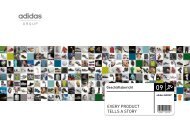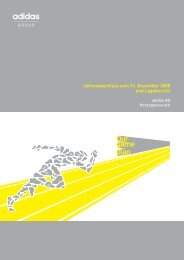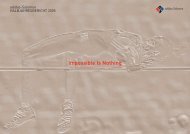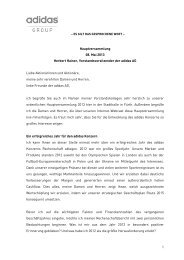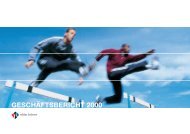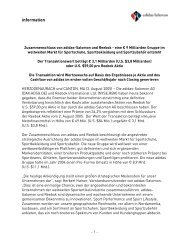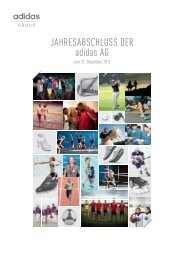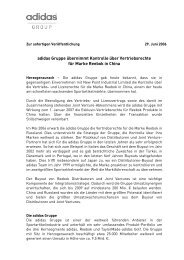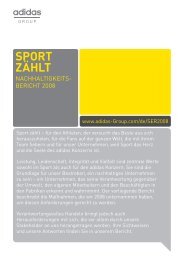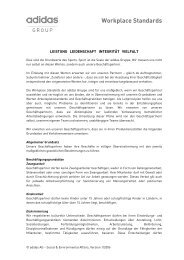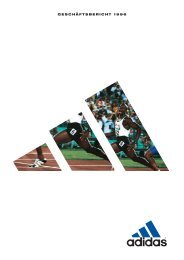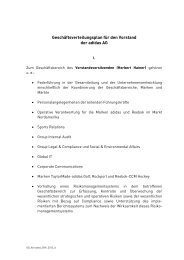Environment PDF - adidas Group
Environment PDF - adidas Group
Environment PDF - adidas Group
You also want an ePaper? Increase the reach of your titles
YUMPU automatically turns print PDFs into web optimized ePapers that Google loves.
ASSESSING MATERIALS<br />
The <strong>adidas</strong> group has been developing a set of internal<br />
criteria for the assessment of materials. We consider<br />
several factors when we are evaluating the sustainability of<br />
materials including land use, elimination of toxic substances,<br />
animal welfare, energy consumption and water consumption.<br />
deVeLOpINg AN ASSeSSmeNT TOOL<br />
To ensure we had a common process across the <strong>adidas</strong><br />
group for assessing the environmental impact of materials,<br />
we created the Tool for the environmental Assessment<br />
of materials or TeAm. Aware of the fact that Life Cycle<br />
Assessments (LCA) are not always available, we knew we<br />
needed alternative ways to make a credible assessment of<br />
a material.<br />
The principal characteristics of the tool are that:<br />
• The assessments are based on a life cycle approach<br />
• It is applicable to all our main sectors: footwear, apparel<br />
and accessories and gear<br />
• It uses knowledge widely held in the apparel and footwear<br />
industry<br />
• It can be explained and communicated to external<br />
stakeholders<br />
• It reflects the needs of the <strong>adidas</strong> group, as well as the<br />
individual brands<br />
• It can be integrated into existing guidelines, such as<br />
<strong>adidas</strong> Better place.<br />
TeAm VeRSION 1<br />
The tool has been developed using both qualitative and<br />
quantitative measures. It builds on a life cycle approach<br />
and uses criteria to assess the impact across several<br />
environmental impact categories. Applying a weighting to the<br />
different impact scores gives one topline score.<br />
The tool includes a matrix design, whereby the:<br />
• Criteria are oriented horizontally in matrix<br />
• Indicators are oriented vertically in matrix.<br />
The criteria are the main environmental impact categories:<br />
• Base material (including land use, biodiversity, and<br />
similar criteria that are differentiated and more complex<br />
in nature)<br />
• Water<br />
• Waste<br />
• environmental toxicity<br />
• Human toxicity<br />
• energy.<br />
This first version of the tool will be amended following the<br />
results of work done in working groups and after input from<br />
external parties. It is also anticipated that the tool may be<br />
integrated into the work of the Apparel Coalition.<br />
BETTER COTTON<br />
01 ABOUT OUR pROgRAmme<br />
17 eNVIRONmeNT<br />
41 SUppLIeRS<br />
57 empLOYeeS<br />
64 COmmUNITY<br />
72 peRfORmANCe<br />
102 gRI INdex<br />
The Better Cotton Initiative (BCI) aims to make global<br />
cotton production sustainable. By 2018 the <strong>adidas</strong><br />
group has committed to using 100% ‘Sustainable<br />
Cotton’ in all its brands.<br />
The <strong>adidas</strong> group is a founding member of the BCI, which<br />
works with organisations from across the cotton supply chain<br />
and interested stakeholders to address the negative social<br />
and environmental impacts of mainstream cotton farming,<br />
such as excessive pesticide and water use. BCI’s philosophy<br />
is to develop a market for a new mainstream commodity –<br />
‘Better Cotton’ – and thereby transform the cotton sector to<br />
bring long-term benefits for the environment, farmers and<br />
other people dependent on cotton for their livelihood.<br />
CReATINg THe mARKeT<br />
We are not alone in setting a target to use 100% ‘Better<br />
Cotton’. Other leading brands in the BCI such as IKeA,<br />
H&m, marks and Spencer and Levi’s have made a similar<br />
commitment. Together we have become part of the Better<br />
Cotton fast Track programme (BCfT). Our commitment<br />
and support can help create the market for this new<br />
sustainable cotton.<br />
As members of the BCfT we are financially supporting<br />
farmer education, which is what is needed to increase the<br />
supply of ‘Better Cotton’ in the future. The funds pledged by<br />
the private partners of the BCfT are matched by the dutch<br />
Sustainable Initiative (IdH), Rabobank and ICCO, an interchurch<br />
organisation for development cooperation.<br />
Read more about the Better Cotton fast Track programme at<br />
http://www.bettercotton.org/index/194/better_cotton_fast_<br />
track_programme.html.<br />
meeTINg OUR TARgeT<br />
We have set incremental annual targets for the quantity of<br />
‘Better Cotton’ we will use, starting from 2010, to keep us<br />
on track for our target of 100% by 2018. This ‘Better Cotton’<br />
target is part of our environmental Strategy 2015.<br />
It is an ambitious target – the first ever harvest of ‘Better<br />
Cotton’ was only in October 2010. And although we have<br />
managed to secure some of this first harvest ‘Better Cotton’,<br />
this target is not without its risks. To manage these risks<br />
and ensure we can meet our target, we are going beyond<br />
engaging with our material suppliers and we are dealing<br />
with cotton ginners directly, in cooperation with our material<br />
suppliers. This level of engagement helps us understand<br />
the challenges and opportunities at each stage of the supply<br />
chain.<br />
IN THE REAL WORLD PERFORMANCE COUNTS Sustainability Report 2010<br />
28



